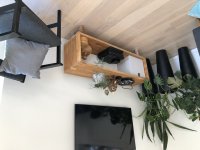Hi all,
I would like your input to what tools would make most sense for me to purchase to improve my shop.
I prefer to build with Oak tree between 2 - 3.5 cm thickness This is the type of projects I want to do :
Rectangular TV furniture
View attachment 1
- Sofa table (To match the TV furniture)
- Freestanding wardrobes (Oak sides + top and MDF or Ply doors and shelves)
- Sunlounges. Mostly build of hardwood but also some nordic softwood.
I prefer to do bevel cuts with domino joints.
I have a TS55 but I'm having some trouble doing accurate 45 degree bevel cuts. I get inconsistant results...not by a lot, but enough that I do want to see if there is any alternative...myabe it's because Im a lefty? [embarassed]
My current tabel saw is a Evolution Rage-5S. Thats not well suited for the task either. Tried to build a sled for it, but the t-tracks is not the same width from start to end, so thats a no-go as well. Also, it's a real PITA to cross cut a long board on it even with two people.
My workshop is 180 sq.ft., so space is somewhat limited. My current considerations:
- Festool CS70 with outrigger table and extensions. I read the reviews in the forum, so not sure on that one, but still like it somehow. Also is there a new with the SawStop tech. coming soon?
- Hammer K3 or C3 with outrigger table, but that will really be a tight fit in my shop, but doable.
- Jet table saw (Same problems as above, but cheaper and likely less quality?)
What do you guys suggest if you could stitch together a setup for me within a $10k budget.
BTW: Looking at TSO for a solution to breaking down 8x4 sheets to more manageable size but with high accuracy, so I don't need to run it through the table saw. Would you go with the full parallel guide system or just start with the guide rail square?
Let me hear your suggestions or if you need me to collaporate something [smile]
I would like your input to what tools would make most sense for me to purchase to improve my shop.
I prefer to build with Oak tree between 2 - 3.5 cm thickness This is the type of projects I want to do :
Rectangular TV furniture
View attachment 1
- Sofa table (To match the TV furniture)
- Freestanding wardrobes (Oak sides + top and MDF or Ply doors and shelves)
- Sunlounges. Mostly build of hardwood but also some nordic softwood.
I prefer to do bevel cuts with domino joints.
I have a TS55 but I'm having some trouble doing accurate 45 degree bevel cuts. I get inconsistant results...not by a lot, but enough that I do want to see if there is any alternative...myabe it's because Im a lefty? [embarassed]
My current tabel saw is a Evolution Rage-5S. Thats not well suited for the task either. Tried to build a sled for it, but the t-tracks is not the same width from start to end, so thats a no-go as well. Also, it's a real PITA to cross cut a long board on it even with two people.
My workshop is 180 sq.ft., so space is somewhat limited. My current considerations:
- Festool CS70 with outrigger table and extensions. I read the reviews in the forum, so not sure on that one, but still like it somehow. Also is there a new with the SawStop tech. coming soon?
- Hammer K3 or C3 with outrigger table, but that will really be a tight fit in my shop, but doable.
- Jet table saw (Same problems as above, but cheaper and likely less quality?)
What do you guys suggest if you could stitch together a setup for me within a $10k budget.
BTW: Looking at TSO for a solution to breaking down 8x4 sheets to more manageable size but with high accuracy, so I don't need to run it through the table saw. Would you go with the full parallel guide system or just start with the guide rail square?
Let me hear your suggestions or if you need me to collaporate something [smile]

